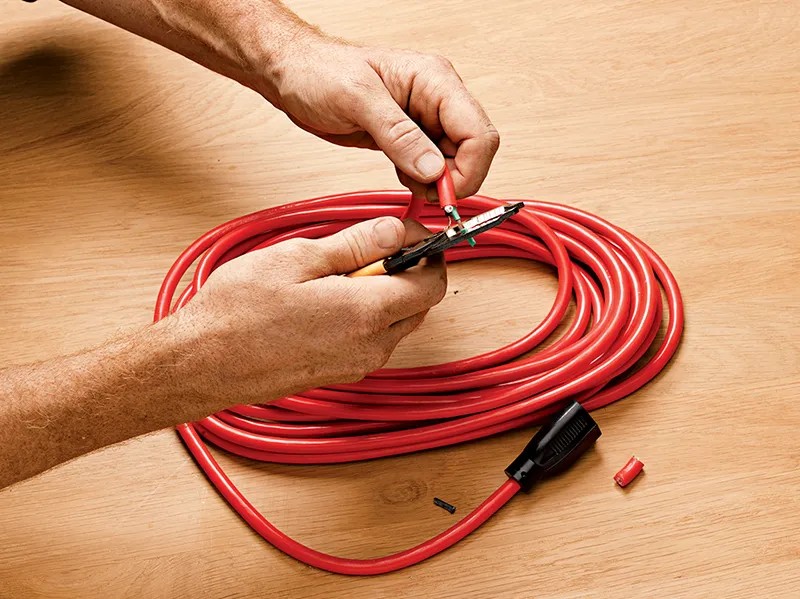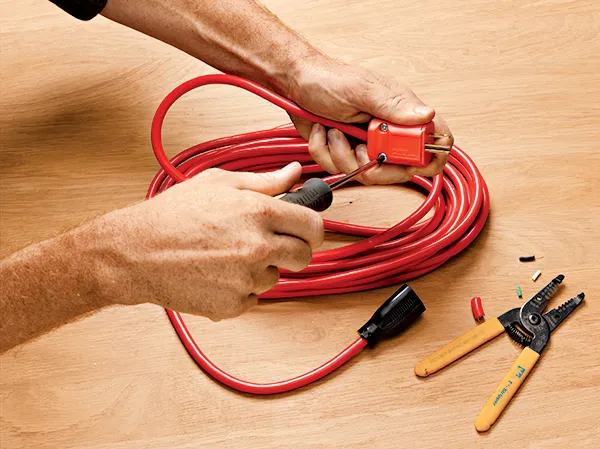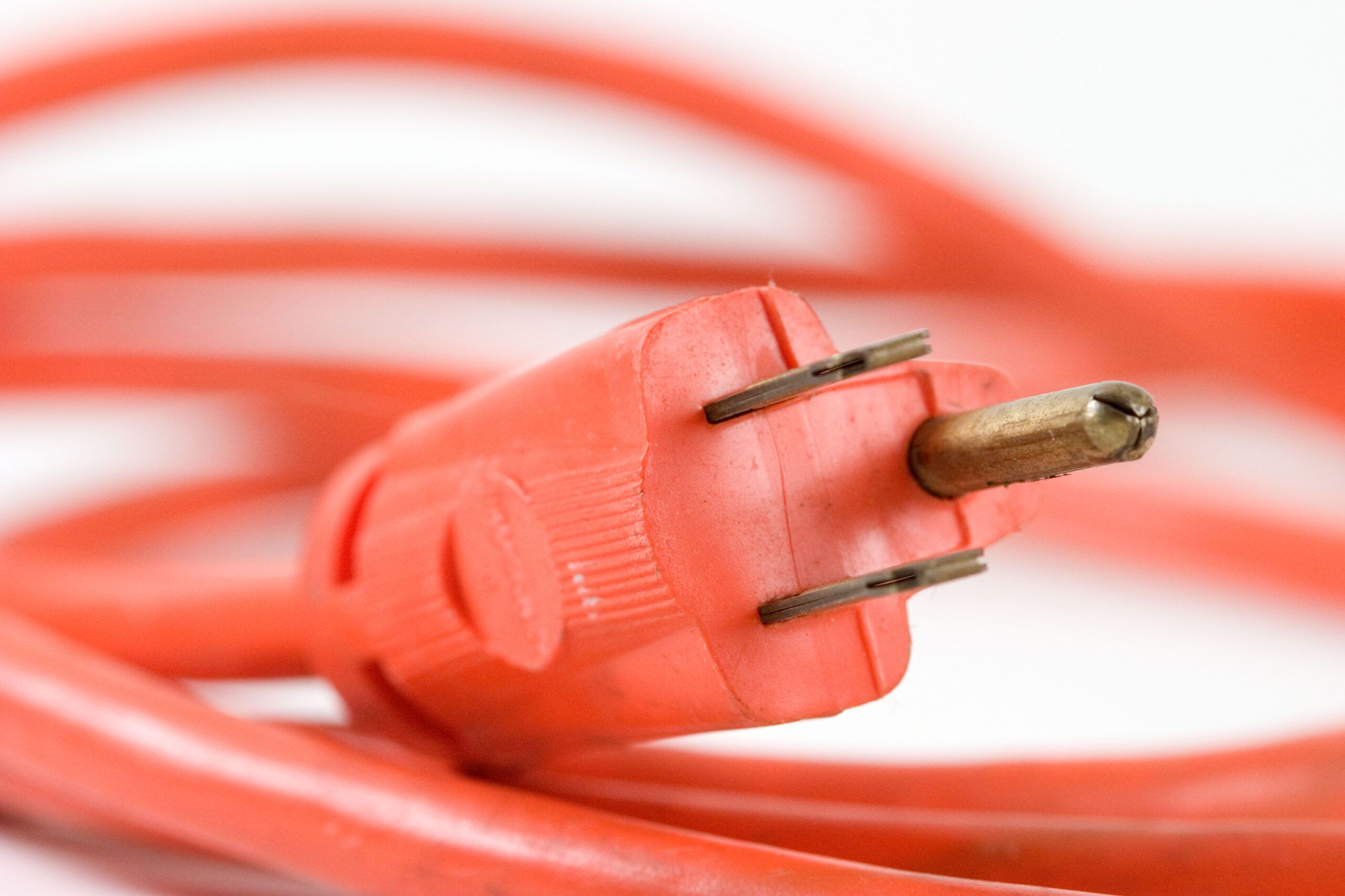Extension cords are necessary for many tasks, but their plugs can wear over time. Knowing how to replace an extension cord plug can save you money and extend your cord’s life. Whether you’re dealing with a bent prong or a completely broken plug, we’ll cover everything you need to know to tackle this simple do-it-yourself (DIY) repair.
Types of Extension Cord Plugs
There are several types of extension cord plugs, each designed for specific uses.
- Two-prong plugs are used for basic household appliances that don’t require grounding.
- Three-prong plugs, the most common type, feature a ground pin for added safety.
- Locking plugs are designed to stay securely connected and are often used in industrial settings.
- Heavy-duty plugs are built to withstand harsh conditions and high-amperage loads.
Each type has its own specific uses and advantages. When selecting a replacement plug, it’s important to choose one that matches your extension cord’s specifications and your usage needs.
Common Issues With Extension Cord Plugs
Extension cord plugs can face various problems over time, including the following:
- Bent or broken prongs
- Corrosion on metal parts
- Cracked or melted plastic housing
- Exposed wires
- Loose connections
Recognizing these issues early can help prevent electrical hazards and avoid potential injuries or fire risks.
Safety Precautions Before Replacing
When attempting to replace an extension cord plug, prioritize safety over everything else. Follow these precautions:
- Inspect the entire cord for damage beyond the plug.
- Unplug the cord from any power source.
- Use insulated tools to prevent accidental shocks.
- Work in a well-lit, dry area.
Safety should always be your top concern when working with electrical components. Never attempt to repair a cord while it’s plugged in. If you’re unsure about any step in the process, call a professional electrician.
Tools and Materials Needed To Replace
Gathering the right tools and materials before you begin will make the replacement process smoother. Here’s what you’ll need:
- Circuit tester (optional but recommended)
- Electrical tape
- Flathead and Phillips screwdrivers
- Replacement plug (matching the amperage of your cord)
- Utility knife
- Wire strippers
Step-by-Step Guide To Replace an Extension Cord Plug
Carefully follow these steps to replace your own extension cord plug.
Remove the Old Plug
- Using wire cutters, make a clean cut about 1 inch from the old plug to remove the damaged plug.
- Carefully remove any remaining outer jacket to expose about 3/4-inch of the inner wires.
- Inspect the inner wires for any signs of damage. If the wires themselves are damaged, you may need to trim back more of the cord and strip the wires again.

Prepare the Cord
- Use a utility knife to split and slice off the jacket about 3/4-inch from the end of the cord. Take care not to cut the three wires inside.
- Using wire strippers, strip 1/2-inch of insulation from the end of each wire.
- Twist the exposed copper strands of each wire to prevent fraying when you attach them to the plug.
Attach Wires To the New Plug
- Open the replacement plug to access the terminal screws inside.
- Attach each exposed copper wire to the appropriate terminal screw:
- Green wire to the green grounding screw
- White (“neutral”) wire to the silver screw
- Black (“hot”) wire to the brass screw
- Wrap each wire clockwise around its respective terminal and tighten the screws securely.
- Ensure there are no stray copper strands that could cause a short circuit.

Reassemble the New Plug
- Carefully tuck the wires into the plug housing, ensuring they don’t cross or touch.
- Close the plug housing and tighten any screws that hold it together.
- Use electrical tape to wrap the area where the cord enters the plug for added protection. This provides an extra layer of safety by reinforcing the connection point.

Extension Cord Wiring Color Codes Explained
You need to know how extension cord wires are color-coded for safe and correct wiring. Each color serves a specific purpose in the electrical circuit.
Green Wire: Ground
The green wire is the ground wire. It provides a safe path for electricity to return to the ground in case of a short circuit or fault, protecting you from electrical shock.
White Wire: Neutral
The white wire is the “neutral” wire. It completes the circuit by carrying current back to the power source. It’s considered the “return path” for the electrical current.
Black Wire: Hot
The black wire is the “hot” or live wire. It carries the electrical current from the power source to the device. This wire is always considered energized and should be handled with extreme caution.
Testing the Newly Replaced Plug
After replacing the plug, make sure it’s working correctly and safely. Here’s how:
- Visually inspect the plug to make sure all connections are tight and no bare wire is exposed.
- Plug the cord into a three-prong receptacle.
- Use a circuit tester on the female end of the cord. The tester’s lights will indicate whether the wires are hooked up correctly and the cord is grounded.
- If you don’t have a circuit tester, you can carefully plug in a small appliance to test the cord’s functionality.
Additional Testing Measures
- Monitor the plug for any signs of overheating or unusual smells during the initial test run.
- Wiggle the plug slightly to ensure it maintains a secure connection and doesn’t exhibit any intermittent connectivity issues.
- If any issues are detected, unplug the cord immediately and double-check the connections.
If the cord fails any of these tests, double-check your connections and repeat the process. If problems persist, consider replacing the entire cord or calling an electrician.
Troubleshooting Common Extension Cord Plug Problems
Even with careful attention to detail, you still might encounter issues when replacing an extension cord plug. Here are some common problems and their solutions.
Loose Connections
If you experience intermittent power or sparking, loose connections may be the culprit. Follow these steps to fix it:
- Unplug the cord immediately.
- Open the plug housing.
- Check that all wires are securely fastened to their terminals.
- Tighten any loose screws.
- Reassemble the plug and test again.
Incorrect Wiring
If your appliance doesn’t work or you get unexpected results, you may have wired the plug incorrectly. Follow these steps to resolve it:
- Unplug the cord and open the plug housing.
- Double-check that each wire is connected to the correct terminal (refer to the color code section).
- If any wires are incorrectly placed, remove them and reattach them to the proper terminals.
- Reassemble and test the plug again.
Damaged Wires
Takes these steps if the internal wires are damaged:
- Trim back the damaged portion and strip the insulation to expose fresh copper.
- Ensure the wires are cut cleanly and not frayed before attaching them to the terminals.
- Follow the color codes carefully to ensure proper connections.
Remember, if you’re unsure about any step or continue to experience problems, it’s best to ask a professional electrician.
When To Replace vs. When To Buy New Plugs
While replacing a plug can extend the life of your extension cord, there are times when it’s better to buy a new cord altogether. Consider replacing the entire cord if you see any of the following issues:
- Signs of wear, fraying, or exposed wires along the cord’s length.
- The cord has been repeatedly repaired or modified.
- The cord has been subjected to extreme conditions
- The cord is very old and may not meet current safety standards.

